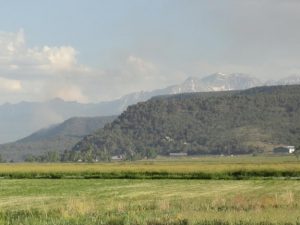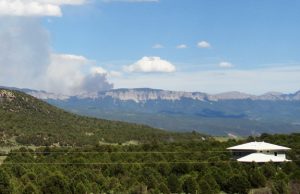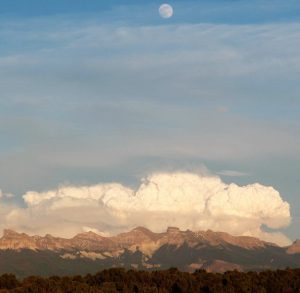As you’ve probably heard in the news, Colorado has been suffering a lot of catastrophic fires this year. A few of them have hit too close to home.

Last Monday, lightning started a fire on a ridge that starts less than a mile east of our house. Luckily, the ridge is about two miles wide, and it was on the other side.
Downwind and uphill is a good place for a fire. It was hard to get to, but my local fire department got there thanks to an ATV or two, and got it under control before it could spread too much (and while my wife and I were away for the day).
Then on Thursday I heard Ridgway’s fire department dispatched to a fire even farther east. That’s pretty much on the edge of their district, and in a place I can see from here, so I went outside and looked.

Sure enough there was a huge plume of smoke, but it was from the other side of the ridge — which puts it outside of our county, in Forest Service land about 20 miles from here. Turns out the Bureau of Land Management was already on it, and Ridgway turned back to keep watch on their own district.
(Click any photo to see larger.)
But Those Were Nothing
The really startling one was Friday, when a fire 50 miles south near Creede, Colo., really blew up, doubling from 7,000ish acres to 15,000 acres in a few hours.
The smoke plume dwarfed a mountain range dotted with 14,000′ peaks. Yikes.

The forest service joined these last two fires and a couple more in this region into one “complex” for planning and suppression purposes, called the “West Fork Complex”. As of today, the fires all together are considered the “most threatening” in the state, and the “highest priority” in the country.
Together, 117 square miles are burning. But we have it easy locally, in that we’re not directly threatened by any of it. Still, it’s pretty uncomfortable because we’re surrounded by forests where even the living trees are considered dryer than kiln-fired lumber, and the winds are stiff every day.
Closer Threat
So yesterday evening, I was writing this week’s True when I heard a dispatch for Ouray Fire Dept. (Ouray is our County Seat). The report was for a fire at a building at a mine that was recently deactivated; people still work there.
The report was that the structure was fully engulfed, with flames threatening trees. That sounds like something to get excited about, but when you’re “in the biz,” you don’t get excited by the initial dispatch: people driving by things often blow what they see way out of proportion, since often they don’t really understand what they’re seeing. “Huge inferno” turns out to be small campfires or bonfires all the time, so I wasn’t concerned.
Not until I heard the update. It wasn’t reported by a passerby, but rather Ouray’s former fire chief: I know he knows what he’s doing, and how to size up a fire. He said flames were 100′, and the fire was spreading.
OK, now I’m a little concerned! But also, since I’m the county’s “radio guy” and I know the area well, I know that there’s no radio coverage in that part of the mountains, several miles up a steep dirt road into a narrow canyon. Structure fires are dangerous. Wildfires are dangerous. Put the two together in a narrow canyon packed with bone-dry trees and the potential for catastrophe is high. If a firefighter gets into trouble, or the fire goes completely out of control, all he can do with his radio is talk to the other firefighters nearby — dispatch will never hear a thing, and won’t know to send help.
So I shot up there — a full half-hour even with lights and siren — and parked on a high spot where I could talk to dispatch, and to the fire chief, and spent hours relaying. Because of the danger, I brought in an ambulance for standby, since we were so far out of town, I wanted medics there in case of injury. If a firefighter was hurt, it otherwise would have taken the ambulance 15-20 minutes to arrive. With them parked next to me, it would instead take 2 minutes. Happily, they were never needed.
Getting the Job Done
I was grateful to see “the troops” arrive. Not just nearly the entire Ouray Fire Dept., which was ahead of me, but two tankers and a brush truck from Ridgway Fire Dept. behind me. About 15 more from the Bureau of Land Management.
Even some firefighters who work as miners at the next mine up the hill came to help. They got there the only way they could: by walking down. It was past 10:00 p.m. before they all finally got it fully contained. One of the firefighters told me that the wind died down in the nick of time: the fire nearly broke through the lines. The forest around there is federal too, so the BLM took over, letting us locals go home to bed. A BLM crew stayed there overnight to ensure it didn’t flare up again.
When the ambulance crew arrived, they told me how nervous the town was. When the fire department is paged out to a call, an air-raid-type siren blows, so everyone in town knows something is up. There were about three pages for this one to get more and more help, so that siren blew again and again. Then the sirens on the firetrucks. Then the sirens from Ridgway’s firetrucks, and the BLM’s. And a BLM helicopter flew in to check things out. And many could probably see the smoke up there. Yeah, you bet the folks in Ouray were nervous! But their firefighters came through for them.
All in all, it was truly cool to see them do the work they love to help the community avoid an utter catastrophe. They beat the odds, which weren’t in their favor with current weather conditions. I won’t really relax until our monsoon season kicks in and it starts raining in earnest, which usually starts around the second week of July.
Safety Support
When I posted briefly about this on Facebook when I got home, a bunch of people called me a hero. Hardly! The firefighters, mostly volunteer men and women, did the hard work. All I did was provide convenience and a safety margin — I let them know someone had their back so they could concentrate on the job.
Did you know that most firefighters in the U.S. are volunteers? About 69 percent of firefighters in America are; about 71 percent of all fire departments, mostly the smaller ones, of course, are exclusively staffed by volunteers (plus 16 percent that are “mostly volunteer” — they may have a few paid staff to be on call more, or help train the others). Now that’s heroic!
Sure, it’s important that they have a lot of support so they can do their jobs, but that’s hardly heroism. After working all day and then spending about 5 hours on this fire, I didn’t get home until nearly midnight, and I was so pooped that I didn’t even try to finish writing: I left it for this morning. Imagine how much more tired the firefighters were, who actually had to work with hoses and shovels in smoke and heat!
It was one heck of an evening for all of us.
– – –
Notes: First, sorry for no photos of the mine fire: I wasn’t on the scene since I needed to be elsewhere to relay communications, and the fire was obscured by hills and trees in between.
Second, I’ve been asked by many what I thought was the cause of the mine building fire. I have no idea. I wasn’t there, there was no speculation relayed to any of the support people like myself, and it takes careful investigation to determine the cause of fires when the start isn’t obvious (say, someone saw the lightning strike!)
I won’t create rumors. I’ll probably find out later, from the local newspaper!
– – –
Bad link? Broken image? Other problem on this page? Use the Help button lower right, and thanks.
This page is an example of my style of “Thought-Provoking Entertainment”. This is True is an email newsletter that uses “weird news” as a vehicle to explore the human condition in an entertaining way. If that sounds good, click here to open a subscribe form.
To really support This is True, you’re invited to sign up for a subscription to the much-expanded “Premium” edition:
Q: Why would I want to pay more than the minimum rate?
A: To support the publication to help it thrive and stay online: this kind of support means less future need for price increases (and smaller increases when they do happen), which enables more people to upgrade. This option was requested by existing Premium subscribers.

Love getting the blog posts…sometimes I imagine a crazy ol’ hermit, sifting thru the “news” all day long. SO glad they HAVE someone like RC out there, doing the Right Thing! I’m pretty sure those heroes out there think might highly of you for “having their backs” up there on the ridge(s) for them! Bravo, Radio Dude!
—
Heh! I like “Radio Dude” — beats “crazy ol’ hermit.” I’m not a hermit, I’m not that old, and I’m not crazy. At least, not very crazy. -rc
You may not consider yourself a hero (and I would be the same way), but you are. Whether you are on the front line, or the back line, you are part of the fraternity that protects and serves. There are people out there that may not be alive if it weren’t for you and your brethren.
I salute you and keep up the great work!
And keep these stories coming. For a short time I lived in that neck of the woods and do miss it so these stories bring back memories.
—
Thanks, Troy — but I still don’t consider myself a hero, even though I know for a fact I’ve saved at least one life recently! To me, a hero does that while risking his or her own life, and I haven’t had to do that. -rc
I just wanted to thank you for what you do and posting these blog entries about it. People like you are what makes it safe for the rest of us. As a fellow Coloradan I have certainly been watching these fires, where I live is only about 20 miles from the Black Forest fire and the (fortunately unneeded) Elbert County evacuation zone came to within 8 miles of my house. Bring on those monsoons!!!
The next time I am up in the Ridgway area I would like to buy you a beer as a thank you for everything.
—
I look forward to it, Paul! -rc
Maybe you’re not a hero, Randy, but you are a guy who steps up to do what others might not, and you deserve recognition for that. So kudos to you and your fellow support personnel, without whom the heroes would have a lot harder time doing their jobs. 🙂
I live just a few hundred yards from the southern edge of the pre-evacuation zone for the Black Forest Fire. We did have a few anxious moments, but for the most part, the fire moved north, not south, and we came through just fine.
Hero or no hero, I’m grateful for everybody who “shows up and does their job” when the fires flare. And that includes you.
And I agree; monsoon season can’t come soon enough. Stay safe.
There may be degrees of heroism, and your definition is a humble one. I think most public safety servants (fire fighters, police, EMTs) are to some degree heroes whenever they answer the call, often with no way of knowing whether their own lives will be in danger for doing so. I’m just glad that volunteers such as you, the fire fighters and others have our back. Good work!
From one “radio guy” (I’m a radio ham in the UK, and a member of “RAYNET” — which is the UK equivalent of RACES and ARES in the USA, and other similar bodies in other countries) to another, what you were doing IS an important part of keeping the place safe. I know, from doing what I do (and I’ve not yet got involved in a real emergency, just helping out at local charity events) and from the people I talk to when doing it, that what we do IS appreciated, and not just by the people we’re actually doing the comms for.
—
To decode Ian’s acronyms: RAYNET is the Radio Amateurs’ Emergency Network; RACES is the Radio Amateur Civil Emergency Service; ARES is Amateur Radio Emergency Service. Amateur Radio is the formal name for “ham” radio, and far from dying out, there are more hams in the U.S. now than at any time in history. Part of the service’s mission is to provide backup communications in case of disaster, which is why it’s fairly typical for the first communications out of a disaster area (like after an earthquake) comes via ham radio operators.
Ian, thanks much for your comments — I appreciate that another “radio guy” really does know exactly what was going on. -rc
Thanks for the information. Hard to get reports on Western Slope Fires when the Front Range has the BIG media.
Your clarity and skill as a journalist is a true blessing to those who want thoughtful, apolitical news!
—
Yeah, we lack professional journalists over here. There are some big fires east of the Divide that are soaking up attention, but there are some big fires over here, too. It has been hard to get information, but our county’s new Emergency Manager has been very good at getting details out, and happily I’m on his mailing list. -rc
I can relate to the craziness, the “radio dude” thing. I live in a town in San Diego County that had MAJOR wildfires in 2003 and 2007. Both involved major loss of homes and thousands of acres burned. I was involved in ham radio communications for both. Mostly in support of my church and the Red Cross.
It has also been a tough weekend. I grew up in Calgary, where there has been MAJOR flooding since Thursday. My parents house did not flood, but it is 3 blocks from the river, and communities within a mile east and west were flooded and evacuated.
I couldn’t do anything about it from here, and my aging parents have been away for almost 2 yrs and will be returning in a month. So they could do nothing. AAARGH.
And about Randy being a hero….of course he is. It doesn’t require much to be a hero. Just do the right thing once. But Randy does it more regularly, and as a volunteer!
—
It’s a bad feeling knowing some sort of disaster is unfolding at home, and you can’t be there! Yeah, the unequal distribution of water is a pain: I sure wish we had an inch of Calgary’s rainfall! That would help them and us both. -rc
Anything that makes a firefighter’s job easier and makes them more effective is a great undertaking. The firefighters I came into contact with have been professional and wonderfully kind. Not so much local law enforcement. Glad they got this one under control. Hoping July brings rain and not just more heat.
We just spent a week evacuated for the Black Forest fire–it started a mere half mile from our house. Thankfully, we came through unscathed. This week we’re going on a long-planned camping trip to Ridgway State Park! We’re hoping to de-stress and take a much-needed break away from fires and smoke.
So glad you and “the troops” are on top of things out there!
—
I hope very much your visit here is smoke free! -rc
Can I ever relate! It’s dry as a bone in N. Arizona. Our Doce fire here in the Prescott area is “almost” under control as I write, but it has been a suspenseful week. No matter which way the wind shifted, we had friends with homes in the path of the fire. Thanks to the courageous firefighters and support personnel, the worst that happened, other than the evacuation of over 400 people, was that a few backyards got singed. I am so grateful to people like you, Randy, who keep our friends and us safe.
You say that you’re not a hero. I won’t argue with you, even though you’re wrong.
The thing that “civilians” (like me) should, and hopefully do, remember about Firefighters is this:
When everyone else is running OUT, Firefighters are running IN!
‘nuf said!
—
This (as they say) is True! And I can say that because …I’m not a firefighter. I was just there to back them up. -rc